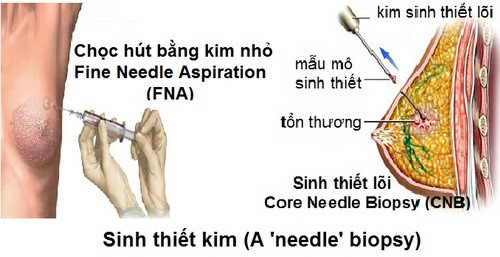Tests help detect cancer early
In 2015, Vietnam had 150,000 cases of cancer and 75,000 deaths. According to health experts, early detection, treatment and surgery can remove tumors and prevent recurrence to 90%.
According to Assoc. Nguyen Nghiem Luat - former Head of Department of Chemistry - Biology, Hanoi Medical University, some types of cancer can show pathological signs such as skin cancer, cervix, breast, rectum and mouth, should be can be diagnosed and treated at an early stage.
Here are some tests that can help diagnose cancer early.
1. Blood and urine tests
The method of finding cancer marks - or more accurately, the quantitative markers of cancer in the blood - are also of certain value if you know how to use them. This test is really helpful in assessing the severe, mild condition as well as predicting the course of the disease during treatment.
A blood test that helps in cancer diagnosis such as PSA antigen testing helps detect prostate cancer; CA 125 antigen test - a form of 125 cancer antigen - in the blood helps detect ovarian cancer; CA 199 test finds pancreatic, stomach cancer .
However, blood tests often have to be combined with other tests to give the most accurate results. Experts say the blood test does not confirm the cancer cells, because the results are sometimes negative, sometimes positive.

Biopsy tests for breast cancer.
2. Image diagnosis
Imaging diagnostic tests used in cancer diagnosis include x-rays, ultrasound, computerized tomography, magnetic resonance imaging or PET-CT to help doctors see details of internal organs. body, at the same time detects abnormalities, such as tumors.
The PET-CT method is a nuclear medical device that uses a combination of PET and CT technology, can detect about 80% of all cancers, even early cancers immediately after the body only new pathological changes in metabolism have not yet formed structural damage.
In addition, the device helps search for patients with metastatic cancer location, primary cancer location, help doctors predict and have effective treatments.
3. Biopsy
A biopsy is a cancer diagnostic test that is applied to almost all types of cancer, because it provides the most accurate results. Usually, doctors will give a biopsy after a series of tests, such as X-rays, CT . and the tumor has been identified. In this test, the doctor will surgically remove some tissue and observe under a microscope to look for signs of cancer.
4. Medullary test to detect blood cancer
Medullary tests have many methods to identify blood cancers, including: Immunophenotyping tests; genetic cell testing; Cerebrospinal fluid test.
This method helps to more accurately determine a patient's ability to develop blood cancer. According to this method, experts will proceed to marrow and take tests to classify and identify blood cells in the marrow. If the amount of Junvenile cell in the blood is elevated, exceeding 5% or even more than 30%, it is possible to identify patients with leukemia.
5. Cervical cell test
Pap tests are used to detect precancerous cells before they can turn into invasive cancer. If precancerous cells are found, treatment and prevention can be conducted before it begins cancer.
Currently, many places have used the ThinPrep Pap test to detect cervical cancer. ThinPrep Pap is an improved cervical smear (Pap smear) in which cervical materials are not smeared into a slide to serve as a smear test. Conventional cervix, which is fully washed into a forming liquid in a ThinPrep bottle and shipped to the laboratory, is processed by a ThinPrep machine to make the specimen fully automated.
The ThinPrep Pap test is much better at detecting squamous cell epithelial lesions, precancerous changes and cervical cancer than the regular Pap smear test.
6. Colonoscopy
Colorectal cancer is a common cancer in the world as well as in Vietnam, in which men and women can get it. This is the 5th most common cancer after lung, stomach, liver, and breast cancer.
Most colorectal cancer occurs in people over 50 years old. Therefore, colonoscopy is needed for people over the age of 50, including those without symptoms. In which ductal colorectal endoscopy is the only method that can conduct biopsy (or removal of colorectal polyps) to confirm the diagnosis of colorectal cancer by histopathology.
- New tests help diagnose liver cancer early
- Blood test method helps detect cancer 5 years early
- Find out how to detect cancer early
- Find out how to detect ovarian cancer early
- Early detection of ovarian cancer thanks to regular blood tests
- Liquid biopsy: The dream of the world's most prominent oncologist
- Breath tests can detect breast cancer
- Blood tests can help detect lung cancer early
- Early diagnosis of pancreatic cancer with a drop of blood
- New technique for early detection of cancer
- First blood test to detect melanoma early
- New tests help detect esophageal cancer
 New drug causes cancer to 'starve'
New drug causes cancer to 'starve' Why is Australia the country with the highest cancer rate in the world while Vietnam ranks 100th?
Why is Australia the country with the highest cancer rate in the world while Vietnam ranks 100th? Common cancers in men
Common cancers in men America's incredible discovery: The most feared cancer cell is love
America's incredible discovery: The most feared cancer cell is love